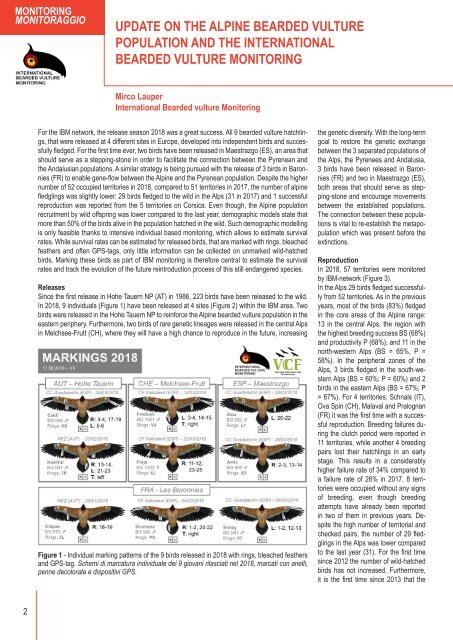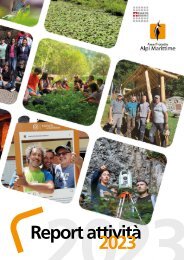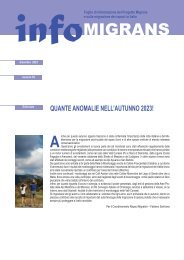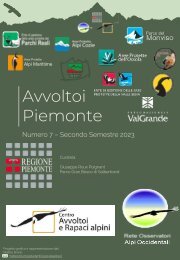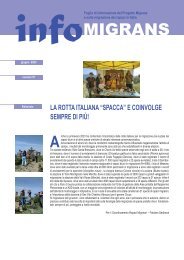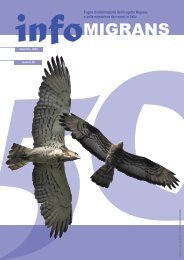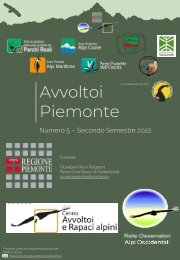infoGIPETO n.35 | dicembre 2018
Periodico d'informazione sul progetto di reintroduzione del gipeto.
Periodico d'informazione sul progetto di reintroduzione del gipeto.
You also want an ePaper? Increase the reach of your titles
YUMPU automatically turns print PDFs into web optimized ePapers that Google loves.
MONITORING<br />
MONITORAGGIO<br />
UPDATE ON THE ALPINE BEARDED VULTURE<br />
POPULATION AND THE INTERNATIONAL<br />
BEARDED VULTURE MONITORING<br />
Mirco Lauper<br />
International Bearded vulture Monitoring<br />
For the IBM network, the release season <strong>2018</strong> was a great success. All 9 bearded vulture hatchlings,<br />
that were released at 4 different sites in Europe, developed into independent birds and successfully<br />
fledged. For the first time ever, two birds have been released in Maestrazgo (ES), an area that<br />
should serve as a stepping-stone in order to facilitate the connection between the Pyrenean and<br />
the Andalusian populations. A similar strategy is being pursued with the release of 3 birds in Baronnies<br />
(FR) to enable gene-flow between the Alpine and the Pyrenean population. Despite the higher<br />
number of 52 occupied territories in <strong>2018</strong>, compared to 51 territories in 2017, the number of alpine<br />
fledglings was slightly lower: 29 birds fledged to the wild in the Alps (31 in 2017) and 1 successful<br />
reproduction was reported from the 5 territories on Corsica. Even though, the Alpine population<br />
recruitment by wild offspring was lower compared to the last year, demographic models state that<br />
more than 50% of the birds alive in the population hatched in the wild. Such demographic modelling<br />
is only feasible thanks to intensive individual based monitoring, which allows to estimate survival<br />
rates. While survival rates can be estimated for released birds, that are marked with rings, bleached<br />
feathers and often GPS-tags, only little information can be collected on unmarked wild-hatched<br />
birds. Marking these birds as part of IBM monitoring is therefore central to estimate the survival<br />
rates and track the evolution of the future reintroduction process of this still endangered species.<br />
Releases<br />
Since the first release in Hohe Tauern NP (AT) in 1986, 223 birds have been released to the wild.<br />
In <strong>2018</strong>, 9 individuals (Figure 1) have been released at 4 sites (Figure 2) within the IBM area. Two<br />
birds were released in the Hohe Tauern NP to reinforce the Alpine bearded vulture population in the<br />
eastern periphery. Furthermore, two birds of rare genetic lineages were released in the central Alps<br />
in Melchsee-Frutt (CH), where they will have a high chance to reproduce in the future, increasing<br />
Figure 1 - Individual marking patterns of the 9 birds released in <strong>2018</strong> with rings, bleached feathers<br />
and GPS-tag. Schemi di marcatura individuale dei 9 giovani rilasciati nel <strong>2018</strong>, marcati con anelli,<br />
penne decolorate e dispositivi GPS.<br />
the genetic diversity. With the long-term<br />
goal to restore the genetic exchange<br />
between the 3 separated populations of<br />
the Alps, the Pyrenees and Andalusia,<br />
3 birds have been released in Baronnies<br />
(FR) and two in Maestrazgo (ES),<br />
both areas that should serve as stepping-stone<br />
and encourage movements<br />
between the established populations.<br />
The connection between these populations<br />
is vital to re-establish the metapopulation<br />
which was present before the<br />
extinctions.<br />
Reproduction<br />
In <strong>2018</strong>, 57 territories were monitored<br />
by IBM-network (Figure 3).<br />
In the Alps 29 birds fledged successfully<br />
from 52 territories. As in the previous<br />
years, most of the birds (83%) fledged<br />
in the core areas of the Alpine range:<br />
13 in the central Alps, the region with<br />
the highest breeding success BS (68%)<br />
and productivity P (68%), and 11 in the<br />
north-western Alps (BS = 65%, P =<br />
58%). In the peripheral zones of the<br />
Alps, 3 birds fledged in the south-western<br />
Alps (BS = 60%; P = 60%) and 2<br />
birds in the eastern Alps (BS = 67%; P<br />
= 67%). For 4 territories, Schnals (IT),<br />
Ova Spin (CH), Malaval and Pralognan<br />
(FR) it was the first time with a successful<br />
reproduction. Breeding failures during<br />
the clutch period were reported in<br />
11 territories, while another 4 breeding<br />
pairs lost their hatchlings in an early<br />
stage. This results in a considerably<br />
higher failure rate of 34% compared to<br />
a failure rate of 26% in 2017. 8 territories<br />
were occupied without any signs<br />
of breeding, even though breeding<br />
attempts have already been reported<br />
in two of them in previous years. Despite<br />
the high number of territorial and<br />
checked pairs, the number of 29 fledglings<br />
in the Alps was lower compared<br />
to the last year (31). For the first time<br />
since 2012 the number of wild-hatched<br />
birds has not increased. Furthermore,<br />
it is the first time since 2013 that the<br />
2


